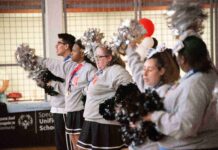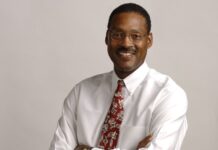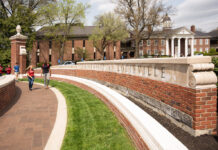Over the last academic year, the work of 65 UofL faculty resulted in new or renewed U.S. patents, licenses and options. Their discoveries include the means to
- repair damaged heart tissue
- more easily identify cancer cells
- identify hazardous chemicals and explosives from trace amounts
- gain probable human injury data from crash-test dummies.
Making new discoveries, however, is only part of the university’s purpose.
“We not only learn new things, but we embrace as part of our mission getting that knowledge out where it actually helps people,” said Bill Pierce, executive vice president for research and innovation. “If we just discover new things and nothing comes from them, then nobody benefits from them.”
Seeking patents, licenses and options—each of which has a different part in the research and development process—is one way that UofL shares its discoveries. In simple terms, a patent is a government grant that gives an inventor the sole right to make, use and sell his or her invention for a set period of time; it protects the idea behind the invention. A license is an agreement between the patent holder and an outside party that allows the outside party to develop, distribute and sell an invention in the commercial market—provided it pays royalties to the patent holder on any profit it makes. An option is an agreement whereby a patent holder allows an outside party limited access to an invention for further development.
UofL holds the patents, licenses and options of its faculty’s work and pays as much as a 50 percent royalty to the faculty members who made the discoveries. “I believe that this is the most generous patent royalty policy of any university,” Pierce said.
It’s incentive to keep inventing, he explained.
“We want our inventors…to invent because that’s what they’re good at. It is every bit as valuable for them to turn (their inventions) over to a company (for further development) and go back to the laboratory and invent something else” as it is for them to fully develop their inventions, Pierce said.
Pierce, President James Ramsey and Provost Shirley Willihnganz recently recognized the faculty whose work resulted in new or renewed U.S. patents, licenses and options in the 2012 ‒ 2013 academic year. They are:
Patents
Roberto Bolli, School of Medicine, identified and isolated a subpopulation of bone marrow-derived mesenchymal stem cells for use in tissue repair and regeneration that is expected to significantly improve the efficiency of stem cell-mediated cardiac repair.
Jason Chesney and Sucheta Telang, School of Medicine, confirmed the role of specific enzymes in the glycolytic process and describe compounds that block the action of those enzymes, inhibiting the growth of cancer cells and and slowing disease progression. This technology is licensed to a local company, Advanced Cancer Therapeutics (ACT).
Jon Klein and Michael Merchant, School of Medicine, found methods of using biomarker levels to diagnose the presence of a kidney disease or the risk of developing such a disease.
Donald Miller, Shelia Thomas and Kara Sedoris, School of Medicine, demonstrated the ability of a compound to selectively inhibit cancer cell metabolism and cell growth. This patent has been licensed to a local company, Advanced Cancer Therapeutics (ACT).
Roland Valdes and Mark Linder, School of Medicine, developed software and methods to determine the correct dosing regimen of warfarin, a common “blood-thinner,” based on a particular patient’s genetic factors and personal attributes. This personalized medicine management tool has been licensed to PGXL, a local startup company.
Laman Gray and George Pantalos, School of Medicine, and Julia Aebersold and Guruprasad Giridharan, J.B. Speed School of Engineering, developed a prototype device that allows for long-duration sensing of blood pressure in patients who have undergone surgery. It allows measurement of blood pressure while minimizing the associated complications that often arise from traditional methods.
Mark Crain, Michael Martin and Kevin Walsh, J.B. Speed School of Engineering, invented a system that collects, detects and analyzes the presence of trace amounts of hazardous chemicals from vapors or gases.
Julia Aebersold, Michael Martin and Kevin Walsh, J.B. Speed School of Engineering, invented a system to detect and sample trace amounts of explosives, chemical agents and other hazardous substances that would go undetected by traditional detection devices.
Aly Farag, J.B. Speed School of Engineering, developed a novel, minimally invasive device to measure a patient’s arterial pulse using thermal imaging. It could lead to improvements in the early detection of cardiovascular disease as well as noncontact improvements in post-critical care.
Jeffrey Hieb and James Graham, J.B. Speed School of Engineering, found a way to provide an effective and economical way to enhance the security of Supervisory Control and Data Acquisition systems, used widely in many industries for monitoring and controlling such processes as electrical switching, chemical processing, oil and gas use, and water/wastewater flow, without compromising system performance.
Carolyn Klinge, School of Medicine, Gamini Sumanasekera, College of Arts and Sciences, and Thomas Roussel and Rob Keynton, J.B. Speed School of Engineering, developed a technology capable of electrokinetically separating multiple molecules, including proteins and nucleic acids, from minute samples. It will have valuable uses in the medical industry.
Douglas Dillon Taylor and Cicek Gercel-Taylor, School of Medicine, discovered the means to isolate and modify cancer cell-derived exosomes to be used as vaccines for treating various cancers.
Douglas Dillon Taylor and Cicek Gercel-Taylor, School of Medicine, developed a method to screen exosomes to determine the presence of cancer and identify the specific tumor type.
Gina Bertocci, J.B. Speed School of Engineering, developed an “intelligent” test dummy capable of simulating and evaluating injuries that a human subject would experience under particular conditions.
Francis Zamborini, College of Arts and Sciences, developed chemical switches and sensors for the detection and storage of hydrogen for fuel cell applications.
Licenses
Sufan Chien, School of Medicine: Exclusive license with Energy Delivery Solutions to permit development of products delivering large amounts of cellular energy to cells in the form of adenosine-5′-triphosphate (ATP).
Richard Cloud, Patrick McKiernan and Drusilla Kemp, Kent School of Social Work: Exclusive license with Carebetter Addiction Practices LLC, an Internet and mobile phone-based addiction recovery support company, for software programs that have a Web and mobile based addiction relapse predictor/prevention mechanism; create a person-to-person email and text-based social support system; and provide a framework to create adherence plans and programs for a variety of conditions, especially addiction recovery.
Kim Noltemeyer, Office of the Vice President for Business Affairs, and Dennis Sullivan, Department of Environmental Health and Safety: Non-exclusive licenses with eight institutions of higher education for a smartphone application that provides emergency procedures; interactive maps; an automatic dialer for safety escorts, university police and 911; information regarding crimes and crime prevention; and links to emergency websites.
Michael Bousamra, School of Medicine: SBC Research Pty Ltd. followed its option with a license to intellectual property describing a metabolomics-derived biomarker to detect early stage cancer and predict responses to chemotherapy.
Ayman El-Baz, Aly Farag and Matthew Nitzken, J.B. Speed School of Engineering: PulmoCAD, a St. Louis startup based around El-Baz’s lung cancer detection and imaging technology, followed an option with a license to evaluate and develop the commercial potential of software for cancer detection and imaging.
Mahendra Sunkara, J.B. Speed School of Engineering, and Gamini Sumanasekera, College of Arts and Sciences: Advanced Energy Materials LLC, followed an option with a license to commercially develop a portfolio of technologies related to nanowire-based materials in various fields including energy storage and conversion.
Jeff Hay and John Kielkopf, College of Arts and Sciences: RDI LLC, followed an option with an exclusive license to develop and commercialize a noncontact imaging sensor system to measure and analyze an object’s position, motion and resonance.
Gerald Hammond and Bo Xu, College of Arts and Sciences: Rigid Solutions, a faculty startup company, has the license to develop a chemical matrix system that will be used to extract chemical products from mixtures of reaction solvents.
Ranganathan Parthasarathy, School of Medicine: Hycult Biotech followed an option with a nonexclusive license agreement for nonclinical manufacture and sale of monoclonal antibodies.
Options
Paula Bates and Tariq Malik, School of Medicine, Gerald Hammond and Bo Xu, College of Arts and Sciences, and Francesca Salipur, student: Option to Kynetic Pharmaceuticals, a startup company, for a cancer therapeutic and diagnostic compound.
Michael Brier, Adam Gaweda, George Aronoff and Alfred Jacobs, School of Medicine: Option with Pharos Medicine LLC, a faculty startup, to commercialize a patented software program for medication dosing.
Kenneth Ramos and Saeed Jortani, School of Medicine: Option with Kentucky Clinical Trial Laboratories LLC, a faculty startup, for a cancer biomarker technology to use in diagnosing cancer.
Manicka Vadhanam, Farrukh Aqil and Ramesh Gupta, School of Medicine: Option with 3P Biotechnologies, a faculty startup, to commercialize technology that allows for targeted delivery of cancer therapeutics.
Robert Berson, J.B. Speed School of Engineering: Option to Unified Manufacturing and Design LLC for an innovative roller-bottle for cell culture that can attain high levels of cell growth and production without cumbersome and expensive equipment or high labor input.
Aly Farag, J.B. Speed School of Engineering: Option with Kentucky Imaging Technologies, a faculty startup, for virtual colonoscopy technology patent and software.
Shamus McNamara, J.B. Speed School of Engineering: Option to Energy Delivery Solutions LLC for a microscale pneumatic pump and device for treating dermal wounds by providing a constant, pressurized dose of topical medication consistently over an extended period of time.
John Naber, Guruprasad Giridharan and Gerald Dryden, J.B. Speed School of Engineering, in collaboration with Joseph Vicars: Option agreement with Endoscopy Assist Devices LLC, a local startup, for an endoscopic snare polyp removal device.
Thomas Rockaway and Gerold Willing, J.B. Speed School of Engineering: Option with IMBA 13-001 for an economical bullet resistant panel that can be incorporated into standard residential and commercial building components to provide ballistic protection to civilian occupants.
Donald Demuth, School of Dentistry, and Frederick Luzzio, College of Arts and Sciences: Option to IMBA 13-002 for technology relating to anti-biofilm compounds for dental applications.
Gina Bertocci and Karen Frost Bertocci, J.B. Speed School of Engineering: Option with Bruce Walker to license a decubitus ulcer prevention garment for dogs with mobility impairment.
Balaji Panchapakesan, J.B. Speed School of Engineering: Option to Integrated NanoSystems LLC for novel nanotube-antibody biosensor arrays for detecting and profiling circulating tumor cells in blood within a matter of minutes.




























